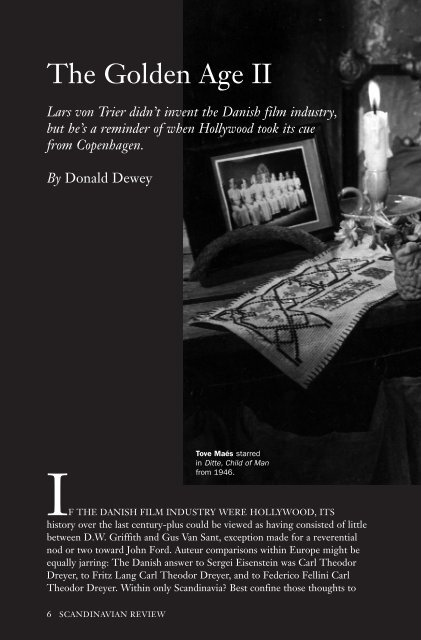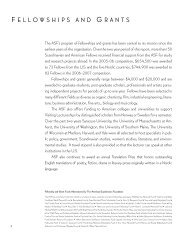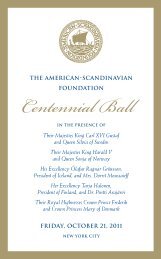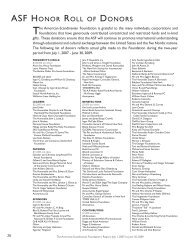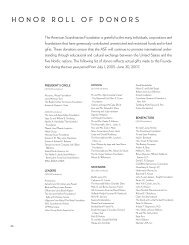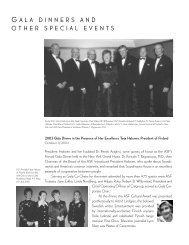Golden Age of Danish Films - The American-Scandinavian Foundation
Golden Age of Danish Films - The American-Scandinavian Foundation
Golden Age of Danish Films - The American-Scandinavian Foundation
You also want an ePaper? Increase the reach of your titles
YUMPU automatically turns print PDFs into web optimized ePapers that Google loves.
<strong>The</strong> <strong>Golden</strong> <strong>Age</strong> II<br />
Lars von Trier didn’t invent the <strong>Danish</strong> film industry,<br />
but he’s a reminder <strong>of</strong> when Hollywood took its cue<br />
from Copenhagen.<br />
By Donald Dewey<br />
IF THE DANISH FILM INDUSTRY WERE HOLLYWOOD, ITS<br />
history over the last century-plus could be viewed as having consisted <strong>of</strong> little<br />
between D.W. Griffith and Gus Van Sant, exception made for a reverential<br />
nod or two toward John Ford. Auteur comparisons within Europe might be<br />
equally jarring: <strong>The</strong> <strong>Danish</strong> answer to Sergei Eisenstein was Carl <strong>The</strong>odor<br />
Dreyer, to Fritz Lang Carl <strong>The</strong>odor Dreyer, and to Federico Fellini Carl<br />
<strong>The</strong>odor Dreyer. Within only Scandinavia? Best confine those thoughts to<br />
6 SCANDINAVIAN REVIEW<br />
Tove Maés starred<br />
in Ditte, Child <strong>of</strong> Man<br />
from 1946.
Finland and Norway and forget about that other country from which people<br />
named Bergman have come. In short, we have never been in the habit <strong>of</strong><br />
thinking <strong>of</strong> Denmark when it comes to the world’s most fecund film nations.<br />
And that would make us slow on the uptake twice—once vis-a-vis the<br />
distant past, the second time within the context <strong>of</strong> the last decade or so. Even<br />
those who might have heard <strong>of</strong> Lars von Trier and his Dogme 95 movement,<br />
if only through the director’s <strong>of</strong>f-screen antics and Breaking the Waves, are<br />
ALL PHOTOS COURTESY OF DANISH FILM INSTITUTE SCANDINAVIAN REVIEW 7
unlikely to recall the global influence <strong>Danish</strong> films had at the dawn <strong>of</strong> the<br />
20th century. How much <strong>of</strong> an influence did they have? Without them<br />
Hollywood would have had a very hard time being Hollywood.<br />
As early as 1889, photographers in Denmark were trying to solve the<br />
mysteries <strong>of</strong> celluloid. <strong>The</strong> public’s first look at movies came on December<br />
16, 1894, when Copenhagen entrepreneur Vilhelm Pacht, whose pursuits<br />
included everything from turning out lithographs to manufacturing paint,<br />
hosted a showing <strong>of</strong> Thomas Edison’s kinetoscope at his Panorama and<br />
Kinoptikon arcade in Rådhuspladsen. But since this was a kind <strong>of</strong> Ripley’s<br />
Museum showing <strong>of</strong> the novel and the bizarre, the country’s first genuine<br />
cinematic experience has usually been traced to the same Pacht’s June 7,<br />
1896 presentation <strong>of</strong> the clips and shorts that French pioneers Louis Jean<br />
and Auguste Lumière were then promoting all over the continent. <strong>The</strong><br />
commotion sparked by the program was such that the royal family dropped<br />
by for a screening four days later. Unfortunately for Pacht, the attention<br />
stirred by the films was matched only by their flammability, and the show<br />
had to close at the end <strong>of</strong> June following a fire. Rumors <strong>of</strong> arson by some<br />
Pacht business rival were proven baseless.<br />
A few months after the flames at the Panorama had been doused, Peter<br />
Elfelt, the royal photographer, lodged his claim as Denmark’s founding<br />
filmmaker by going to a Copenhagen park to take advantage <strong>of</strong> an early<br />
snowfall for shooting Kørsel med grønlandske hunde (Traveling with Greenland<br />
Huskies); it was the first <strong>of</strong> some 200 documentaries he would make between<br />
1896 and 1912. Elfelt was also behind the camera for the eight-minute<br />
Henrettelsen (<strong>The</strong> Execution) in 1903, regarded as the first feature film. Given<br />
his position at the palace, it isn’t surprising that many <strong>of</strong> his pieces captured<br />
kings Christian IX and Frederik VIII and their families at leisure. In 1906,<br />
however, Elfelt began sinking into the shadow cast by Nordisk <strong>Films</strong><br />
Kompagni—an outfit that, in spite <strong>of</strong> more than one formal name change,<br />
periods <strong>of</strong> bankruptcy, and mergers, holds title to being the world’s oldest<br />
continuous production company.<br />
THE POWER BEHIND NORDISK WAS OLE OLSEN, A CINEMA<br />
owner who launched his new line <strong>of</strong> endeavor with a series <strong>of</strong><br />
“big game” shorts. <strong>The</strong> first <strong>of</strong> them, focusing on polar bears, not<br />
only gave Olsen an international hit but also the logo the company has<br />
maintained to this day. Far more troublesome was his second foray, a piece<br />
about a purported African safari entitled Løvejagten (<strong>The</strong> Lion Hunt). Shot<br />
on the tiny island <strong>of</strong> Elleore, its chief characters were an aged horse and<br />
two rheumatic lions purchased from the Hamburg zoo just before they<br />
were to be put down. Although the sick lions proved even more popular<br />
than the polar bears with audiences, they did so mainly outside Denmark<br />
because <strong>of</strong> protests from local humane societies over Nordisk’s treatment<br />
<strong>of</strong> the animals. Authorities stopped production twice and even jailed<br />
8 SCANDINAVIAN REVIEW
A scene from Carl Dreyer’s Ordet (<strong>The</strong> Word) from 1955.<br />
Olsen’s cameraman for a day, forcing completion <strong>of</strong> the project in secret.<br />
When animal rights activists followed up with a lawsuit, Olsen smuggled a<br />
print out to Sweden before his negatives were seized. It was a smart move<br />
because <strong>The</strong> Lion Hunt ended up being banned in Denmark for more than<br />
a year before the suit was dropped. By that time, however, it had titillated<br />
audiences throughout Europe. Aside from <strong>of</strong>fering the opportunity to view<br />
ailing African beasts sneaking around potted plants on Roskilde Fjord, its<br />
allure lay in what was then pretty advanced cinematic language, not least<br />
in the use <strong>of</strong> close-ups and crosscuts.<br />
Over the next few years, Nordisk turned out some 250 films. Much<br />
<strong>of</strong> the company’s success owed to Olsen’s philosophy that the film business<br />
could only thrive as an export business; to this end, he opened <strong>of</strong>fices in New<br />
York, Berlin, Budapest and other cities. One <strong>of</strong> Nordisk’s busiest employees<br />
was actor-director Viggo Larsen, whose credits included a 12-minute version<br />
<strong>of</strong> Camille and the first serious attempt anywhere to adapt the Sherlock<br />
Holmes stories for the screen. Larsen later went on to become one <strong>of</strong><br />
Germany’s leading film players. His place was more than filled at the studio<br />
by August Blom, associated with the three most famous (or infamous)<br />
pictures produced by Nordisk in the silent era. <strong>The</strong> first <strong>of</strong> these was Den<br />
hvide slavehandel (<strong>The</strong> White Slave), 1910, advertised as the country’s first<br />
multi-reel film (it ran to more than a half-hour) but actually a rip<strong>of</strong>f <strong>of</strong> an<br />
identically titled film produced by the Arhus company Fotorama and released<br />
SCANDINAVIAN REVIEW 9
Max von Sydow starred in Hamsun (1996), based on the life <strong>of</strong> Knut Hamsun, Norwegian<br />
Nobel Prize winner in literature. (Opposite) Von Sydow also starred in the popular<br />
Pelle the Conqueror (1988), directed by Bille August. It won the Best Foreign Film Oscar.<br />
a couple <strong>of</strong> months earlier. In 1914, Blom directed Atlantis, a mammoth<br />
production based on the Titanic catastrophe that called for location shooting<br />
in Berlin and New York. <strong>The</strong>n in 1916 he called the shots on the big-budget<br />
Verdens undergang (<strong>The</strong> End <strong>of</strong> the World), a science-fiction fantasy that was<br />
precisely about what its title warned. On most <strong>of</strong> his projects Blom had the<br />
critical assistance <strong>of</strong> either Axel Graatkjaer or Johan Ankerstjerne, the most<br />
creative cameramen <strong>of</strong> the period. Graatkjaer, the photographer jailed during<br />
filming <strong>of</strong> <strong>The</strong> Lion Hunt, specialized in deep focus cinematography,<br />
Ankerstjerne in side lighting.<br />
As popular as Viggo Larsen was as a male lead, neither he nor anyone<br />
else outshone Valdemar Psilander, who made 83 films for Nordisk between<br />
1911 and 1916. Something <strong>of</strong> a Nordic Valentino, Psilander appeared in one<br />
exotic role after another opposite an equally steamy actress and within lavishly<br />
elaborate sets; typical was one picture for which facsimiles <strong>of</strong> the Great<br />
Pyramid and the Sphinx were erected on the desert-like dunes <strong>of</strong> Jutland.<br />
When Psilander died in 1917 at the improbable age <strong>of</strong> 32, his legend was<br />
sealed; his films were reissued and, in many cases, drew even bigger crowds<br />
than they had the first time around.<br />
As dominant as Nordisk was through the first years <strong>of</strong> World War I, it<br />
10 SCANDINAVIAN REVIEW
was not the only game in town. <strong>The</strong> first <strong>Danish</strong> feature running at least an<br />
hour was Den sorte drøm (<strong>The</strong> Black Dream), in 1911. But already the year<br />
before the principals involved in <strong>The</strong> Black Dream had made another, shorter<br />
picture <strong>of</strong> some 34 minutes for the small Kosmorama studio that would revolutionize<br />
more than the local industry. <strong>The</strong> film was Afgrunden (<strong>The</strong> Abyss),<br />
directed by playwright Urban Gad and starring Asta Nielsen. A melodrama<br />
about a middle-class woman who falls for a circus performer, runs <strong>of</strong>f after<br />
him, then murders him in an explosion <strong>of</strong> jealous rage, <strong>The</strong> Abyss was the<br />
first <strong>of</strong> dozens <strong>of</strong> Gad-Nielsen collaborations between 1910 and 1914, initially<br />
in Denmark and then in Germany. More <strong>of</strong>ten than not, they featured<br />
a sensual dance from an elegantly attired Nielsen, at least one extravagantly<br />
long kiss in close-up, a character connected to a circus or carnival, and<br />
someone reaching for a gun in the final frames. Spectators arriving late for<br />
the opening credits would have been hard pressed to tell one lachrymose<br />
tale from another.<br />
BUT THE PLOTS OF THE GAD-NIELSEN TEAMINGS (THEY WERE<br />
also married after beginning their work together) were the least <strong>of</strong><br />
it. Amid the ballyhoo that made her the first authentic screen star,<br />
Nielsen forced even <strong>American</strong> studios to rethink a standing opposition to<br />
billing actors by name; the Dane’s films were simply too pr<strong>of</strong>itable to keep<br />
indulging calculations that too much popularity for an individual performer<br />
would lead to exorbitant contract demands. It was thanks to such<br />
international successes as <strong>The</strong> Abyss and <strong>The</strong> Black Dream that Florence<br />
Lawrence was promoted above the title <strong>of</strong> an item called <strong>The</strong> Broken Oath<br />
and that the star system was launched in the U.S. (<strong>American</strong> producers<br />
acknowledged their inspiration, too. After one studio failed to attract<br />
Nielsen to Hollywood, it signed a Swede with the similar-sounding name<br />
<strong>of</strong> Anna Nilsson.)<br />
<strong>The</strong> Nielsen-Gad influence didn’t end with the star system. Given the<br />
success <strong>of</strong> <strong>The</strong> Abyss in particular,<br />
<strong>Danish</strong> filmmakers didn’t have to have<br />
their arms twisted to produce stories<br />
panting with eroticism; already in 1911,<br />
<strong>The</strong> Black Dream had intense box <strong>of</strong>fice<br />
competition from Blom’s Ved faengslets<br />
port (Temptations <strong>of</strong> the Great City) for<br />
Nordisk. That was the inevitable news.<br />
<strong>The</strong> bleak news was that within acouple<br />
<strong>of</strong> years any resemblance between a<br />
Nielsen vehicle or even Blom’s picture<br />
and the regular fare in Copenhagen<br />
theaters was purely coincidental.<br />
Sensuality gave way to luridness.<br />
SCANDINAVIAN REVIEW 11
Instead <strong>of</strong> a star-crossed heroine chasing<br />
after a circus artist, the stories ran more to<br />
dissolute seamen chasing after scantily clad<br />
sirens or naive students falling into the<br />
clutches <strong>of</strong> scheming hookers; for a change<br />
<strong>of</strong> pace, there were yarns <strong>of</strong> innocent school<br />
girls crossing paths with Asian drug lords<br />
who doubled as white slavers. It wasn’t long<br />
before similarly themed (if relatively less<br />
explicit) pictures were being churned out in<br />
Hollywood and other film capitals, leading<br />
to, among other things, the popularity <strong>of</strong><br />
vamps like <strong>The</strong>da Bara.<br />
Cheapie thrillers weren’t the only features<br />
coming out <strong>of</strong> Denmark in the years<br />
around World War I. With Blom given<br />
more and more to erotic nightmares, the<br />
most innovative director <strong>of</strong> the period was<br />
Benjamin Christensen, a one-time opera<br />
singer who infused such otherwise pedestrian<br />
crime stories as Det hemmelighedsfulde<br />
X (<strong>The</strong> Mysterious X), 1914, and Haevnens nat<br />
(Blind Justice), 1916, with striking visuals.<br />
Christensen soon surpassed Blom as the<br />
critics’ darling, particularly when the latter’s<br />
Atlantis emulated its subject matter by<br />
becoming synonymous with commercial disaster—arguably<br />
the biggest one <strong>of</strong> the estimated<br />
1,600 silent features and shorts produced<br />
by Nordisk.<br />
Nordisk’s Atlantis debacle became an afterthought for the company and<br />
the industry as a whole as World War I went on. Reflecting Denmark’s neutral<br />
stance in the conflict, dramas tended toward pacifist sentiments—an<br />
approach that might have appealed to viewers in Scandinavia but that wasn’t<br />
especially welcomed in other markets. <strong>The</strong>n even harsher realities took over.<br />
At first, Nordisk and other studios dealt passably enough with the warenforced<br />
closing <strong>of</strong> their <strong>of</strong>fices in the United States and most <strong>of</strong> the rest <strong>of</strong><br />
Europe, largely because a considerable portion <strong>of</strong> their foreign business was<br />
with Germany and the besieged Germans had little alternative to the screen<br />
fare being sent to them from Copenhagen. But in 1917, an increasingly desperate<br />
German high command cracked down on foreign enterprises, nationalizing<br />
Nordisk’s pivotal Berlin <strong>of</strong>fice and its dozens <strong>of</strong> cinemas around the<br />
country. <strong>The</strong> mandated merging with Germany’s UFA studios was the beginning<br />
<strong>of</strong> something bad.<br />
12 SCANDINAVIAN REVIEW
Carl Dreyer’s Day <strong>of</strong> Wrath appeared in 1943.<br />
<strong>The</strong> end <strong>of</strong> the war brought the end <strong>of</strong> nationalization decrees, but also<br />
the gradual control <strong>of</strong> world film markets by the United States. In the face<br />
<strong>of</strong> the new economic threat <strong>Danish</strong> producers, especially Nordisk, turned<br />
timid. Instead <strong>of</strong> the provocation that had gone into the erotic films and the<br />
epic eccentricity <strong>of</strong> most costume dramas, studios lavished almost as much<br />
money on safe adaptations <strong>of</strong> Charles Dickens novels and dumb comedies.<br />
In the latter vein, no one was more popular than the team <strong>of</strong> Carl Schenstrøm<br />
and Harald Madsen, known locally as Fyrtårnet og Bivognen (literally,<br />
the Lighthouse and the Sidecar). Forerunners <strong>of</strong> Laurel and Hardy, their<br />
routines proved to be a reliable source <strong>of</strong> income for the small Palladium<br />
company for years. <strong>The</strong> most significant exception to the bland bill <strong>of</strong> fare<br />
in the early 1920s was Christensen’s third film, Häxan (Witchcraft Through<br />
the <strong>Age</strong>s), 1922. One <strong>of</strong> the oddest pictures ever shot in Denmark or anywhere<br />
else, Witchcraft started out as a semi-documentary about witchcraft in<br />
SCANDINAVIAN REVIEW 13
Babette’s Feast (1987), also won a Best Foreign Film Oscar. Its screenplay by director<br />
Gabriel Axel was based on an Isak Dinesen short story.<br />
the Middle <strong>Age</strong>s and Renaissance, but quickly evolved into a horror film<br />
with plenty <strong>of</strong> nudity and torture scenes to satisfy those seeking more than<br />
a history lesson. Shot by Ankerstjerne, it enraptured critics for its use <strong>of</strong><br />
Renaissance paintings for visual references. Although the picture was<br />
banned in several countries, it brought Christensen invitations to work in<br />
Germany and Hollywood.<br />
<strong>The</strong> emergence <strong>of</strong> Dreyer in the 1920s didn’t exactly send the industry<br />
into ecstasy. For one thing, he had been holding down various jobs—title<br />
writer, script writer, editor—at Nordisk since well before the war. For<br />
another, he dazzled few with his initial directing efforts—Praesidenten (<strong>The</strong><br />
President), 1919 and Blade af satans bog (Leaves From the Book <strong>of</strong> Satan),1920.<br />
Thirdly, he wasted little time demonstrating that he would go wherever<br />
the money was for financing his projects, ultimately shooting many <strong>of</strong> his<br />
films outside Denmark with help from whoever <strong>of</strong>fered it, nationality irrelevant.<br />
It was in fact France that put up the money for <strong>The</strong> Passion <strong>of</strong> Joan <strong>of</strong><br />
Arc in 1928.<br />
Dreyer’s portrait <strong>of</strong> the last day in Joan’s life brought new definition to<br />
the word anguish, his fierce close-ups <strong>of</strong> Renée Falconetti (a French stage<br />
actress in her only film role) creating some <strong>of</strong> the most indelible images in<br />
motion picture history. <strong>Danish</strong> critics thought so, too, but their counterparts<br />
in Catholic countries saw a version heavily censored by Church authorities<br />
and could not be quite as enthusiastic, at least immediately. <strong>The</strong> film, which<br />
took more than 18 months to shoot at enormous cost, was a commercial<br />
14 SCANDINAVIAN REVIEW
flop. Already at odds with his French backers over his casual ways with a<br />
budget, Dreyer ended up in a breach <strong>of</strong> contract suit over a second film,<br />
leading to almost five years <strong>of</strong> inactivity. His next angel was a Dutch baron<br />
who put up the financing for Vampyr (<strong>The</strong> Vampire), 1932, with the understanding<br />
that the aristocrat would also play the title role <strong>of</strong> the undead creature<br />
roaming around a creepy castle. An exercise in cold style and with a plot<br />
that verged on the inane, <strong>The</strong> Vampire was Dreyer’s first sound film, its few<br />
lines <strong>of</strong> dialogue postsynched in English, French, and German. Neither this<br />
nor a generally cool critical reception helped at the box <strong>of</strong>fice. For the next<br />
10 years, Dreyer had to make his living as a journalist.<br />
Ins<strong>of</strong>ar as national production fell to a single film in 1928, the depression-weighted<br />
1930s might not have been worse than the 1920s, but it was<br />
a close call. As in other countries with a restrictive language base, the advent<br />
<strong>of</strong> sound in Denmark in 1931 with Praesten i Vejlby (<strong>The</strong> Vicar <strong>of</strong> Vejlby) introduced<br />
as many practical problems as artistic innovations. With the need to<br />
dub or subtitle everything for export, neighboring Germany, the country’s<br />
traditional chief foreign market, moved as far away as England and the Soviet<br />
Union. Exports were further damaged by studio rationalizations that the<br />
nation needed laughs to combat the depression gloom, precipitating a proliferation<br />
<strong>of</strong> dreary “folk comedies” that left the impression <strong>of</strong> an industry<br />
turned provincially inward. <strong>The</strong> one bright spot in the 1930s was in documentaries,<br />
where, most conspicuously, Poul Henningsen’s Danmark (Denmark),<br />
1935, and <strong>The</strong>odor Christensen’s C-et hjorne af Danmark (C-A Corner <strong>of</strong><br />
Denmark), 1938, showed a mastery <strong>of</strong> the form that would continue into the<br />
present century.<br />
NOT ALL THAT IRONICALLY, THE LONGEST RESPITE FROM<br />
the sunshine comedies came during the Nazi occupation <strong>of</strong> Denmark.<br />
For a couple <strong>of</strong> years, before the Germans took away even the<br />
appearance <strong>of</strong> normality, film production actually increased, particularly<br />
with documentaries and a spate <strong>of</strong> crime melodramas that anticipated the<br />
edgy film noir genre. Among the signal names <strong>of</strong> the era was Bodil Ipsen, a<br />
noted Ibsen stage actress who directed the sophisticated comedy En herre<br />
i kjole og hvidt (Black Tie),1942, and the psychological thriller Mordets melodi<br />
(Melody <strong>of</strong> Murder), 1944.<br />
It was also during the Occupation that Dreyer returned to directing,<br />
first with Mødrehælpen (Helping Young Mothers), 1942, a documentary about<br />
<strong>Danish</strong> mothers, then with his masterpiece Vredens dag (Day <strong>of</strong> Wrath), 1943.<br />
As with Christensen a generation earlier, the subject was witchcraft, but this<br />
time with a more concentrated treatment <strong>of</strong> 17th-century <strong>Danish</strong> witchhunt<br />
victims. Given the picture’s harrowing portrait <strong>of</strong> intolerant, obscurantist<br />
rulers, it didn’t take long for it to be viewed as a protest against the occupying<br />
Germans. Before Dreyer was summoned down to debate the point with<br />
the Gestapo, he fled to Sweden, where he remained until the end <strong>of</strong> the war.<br />
SCANDINAVIAN REVIEW 15
Day <strong>of</strong> Wrath was produced by Palladium,<br />
but it was Nordisk that suffered the biggest<br />
material loss during World War II. On<br />
February 7, 1944, Nazi thugs blew up<br />
Nordisk’s lots as well as one <strong>of</strong> its major firstrun<br />
theaters. <strong>The</strong> sabotage crippled the company<br />
for a couple <strong>of</strong> years, but also indirectly<br />
opened the way for its greater appreciation <strong>of</strong><br />
less costly shorts and documentaries. Among<br />
the most prominent postwar directors was the<br />
husband-and-wife team <strong>of</strong> Bjarne and Astrid<br />
Henning-Jensen, who specialized in films for<br />
and about children. <strong>The</strong>ir most well-known<br />
film together was Ditte Menneskebarn (Ditte,<br />
Child <strong>of</strong> Man), 1946, an adaptation <strong>of</strong> a novel<br />
about an orphan living in a hostile rural community.<br />
Astrid Henning-Jensen later went on<br />
to direct several features alone, including one<br />
with her son in the starring role, and was<br />
among the country’s most bankable directors<br />
well into the 1970s.<br />
<strong>The</strong> Abyss, from 1910, starred Asta<br />
Dreyer had his third act in the 1950s with Nielsen and was one <strong>of</strong> the films that<br />
launched the star system in the U.S.<br />
Ordet (<strong>The</strong> Word), 1955, a drama not all that<br />
thematically removed from Day <strong>of</strong> Wrath in its<br />
tale <strong>of</strong> the clash between faith and fanaticism when a man believing he is Jesus<br />
Christ begins performing miracles. Critical praise for the picture instigated<br />
revival showings <strong>of</strong> Dreyer’s earlier work around the world. Although he<br />
announced various other projects until his death in 1968, he managed to<br />
finish only one other feature, Gertrude, 1964, an austere story <strong>of</strong> a woman<br />
asserting her spiritual independence.<br />
Dreyer aside, the 1950s and 1960s were dominated by more banal<br />
comedies <strong>of</strong> the dumb-father-knows-best variety. <strong>The</strong> biggest commercial<br />
director was Erik Balling, who rose to the executive suites <strong>of</strong> Nordisk while<br />
calling the shots on Denmark’s first color feature, Kispus (Puss in the Corner),<br />
in 1956, and whose Qivitoq (the name <strong>of</strong> an Inuit god) the same year was the<br />
first <strong>Danish</strong> film to be nominated for a Foreign Picture Oscar. But Balling’s<br />
greatest contribution to the company came in 1968, when he launched the<br />
first <strong>of</strong> 13 slapstick comedies featuring the so-called Olsen Gang, a band<br />
<strong>of</strong> nitwits whose larcenous schemes inevitably brought disaster. <strong>The</strong> pictures,<br />
somewhat like the “Carry On” series in England, made so much money<br />
for Nordisk that it was able to operate without availing itself <strong>of</strong> government<br />
subsidies until 1981. Balling also produced and/or directed numerous popular<br />
TV series.<br />
From the closing <strong>of</strong> the first major theater in 1959 to the emergence <strong>of</strong><br />
16 SCANDINAVIAN REVIEW
Fyrtårnet og Bivognen (literally, <strong>The</strong> Lighthouse and<br />
the Sidecar), forerunners to Laurel and Hardy, were<br />
a popular between-wars comic team.<br />
von Trier and the Dogme movement in the 1990s, the keynote to the last<br />
half <strong>of</strong> the 20th century was in television’s gradual erosion <strong>of</strong> cinema attendance<br />
figures. Only the odd film reminded foreign audiences that Denmark even<br />
had a motion picture industry, and not always for aesthetic reasons. One was<br />
Johan Jacobsen’s En fremmed banker paa (A Stranger Knocks), 1959, a story <strong>of</strong><br />
a war widow who goes to bed with the Resistance traitor who killed her<br />
husband. Because she discovers his identity from a scar while making love<br />
with him, the picture challenged the standard arguments about the dramatic<br />
gratuitousness <strong>of</strong> sex scenes; in the United States, bans against A Stranger<br />
Knocks led to a 1965 Supreme Court decision abolishing state censorship<br />
boards. In 1987, the industry got a needed shot in the arm when Gabriel<br />
Axel’s Babettes gaestebud (Babette’s Feast) won an Academy Award for Best<br />
Foreign Film. Bille August took another Oscar for Pelle Eroberen (Pelle the<br />
Conqueror) the very next year.<br />
Television apart, the institution with the most impact over the last half <strong>of</strong><br />
the 20th century was the National Film School, founded in 1966. In the<br />
1980s, it established a critical policy stressing filmmaking as a team concept<br />
and implementing that policy by restricting admission to Noah’s Ark-like<br />
pairs <strong>of</strong> directors, producers, editors, cameramen, etc. It was from this cooperative<br />
production training in which directors were no more important than<br />
SCANDINAVIAN REVIEW 17
Lars von Trier’s 1996 film Breaking the Waves<br />
starred Emily Watson and Stellan Skarsgård.<br />
18 SCANDINAVIAN REVIEW<br />
any other member <strong>of</strong> the<br />
team that many <strong>of</strong> the<br />
school’s graduates went on<br />
to set up their own companies,<br />
more <strong>of</strong>ten than not,<br />
with classmates. <strong>The</strong> most<br />
significant <strong>of</strong> the outfits was<br />
Zentropa, set up by von<br />
Trier and producer Peter<br />
Aalbaek Jensen in 1992.<br />
<strong>The</strong> 51-year-old director<br />
already had several lines<br />
on his curriculum vitae before<br />
being identified with<br />
Zentropa or Dogme 95.<br />
His first films and telefilms in the 1980s, which included an old Dreyer script<br />
on the Medea tragedy, ran the gamut <strong>of</strong> genres and styles, but won critical<br />
recognition from the start. A turning point came in 1994, when he directed<br />
the internationally distributed TV series “<strong>The</strong> Kingdom.” A cross between<br />
“ER” and “Twin Peaks”, its tale <strong>of</strong> a hospital with as many ghosts roaming<br />
the halls as patients taking intravenous fluids in beds allowed von Trier and<br />
Aalbeck to finance Breaking the Waves (1996). Shot in semi-documentary<br />
style in English, Breaking the Waves told the story <strong>of</strong> an obsessed Scot (Emily<br />
Watson) who is convinced that the only way to cure her paralyzed husband<br />
is to go to bed with as many men as possible.<br />
But even the acclaim accorded Breaking the Waves (it was awarded<br />
the Gran Prix at Cannes) took second place to von Trier’s declaration <strong>of</strong><br />
principles for what became known as Dogme 95. Attending film centenary<br />
celebrations at Paris’s Odeon theater in March 1995, the director tossed<br />
around leaflets demanding what he called a “vow <strong>of</strong> chastity” by the world’s<br />
film makers. Often reduced by skeptics to a call for hand-held cameras,<br />
the declaration was in fact a nine-point program covering every technical<br />
aspect <strong>of</strong> shooting a motion picture and stipulating a code <strong>of</strong> conduct for<br />
assuring creative candor among the actors and technicians involved. At its<br />
core was criticism <strong>of</strong> the traditional Hollywood (or locally, Nordisk) way <strong>of</strong><br />
approaching productions as individual artisan contributions that lacked<br />
passionate commitment and ballooned budgets to obscene levels. Reiterating a<br />
<strong>Danish</strong> Film School philosophy, von Trier insisted that art had to be restrictive<br />
to succeed.<br />
<strong>The</strong> scene at the Odeon and slews <strong>of</strong> follow-up articles and interviews<br />
provided enormous publicity for Zentropa’s stated ideological aims. Von<br />
Trier himself never missed an opportunity to scandalize with a quote,<br />
whether it was “Lord <strong>of</strong> the Rings, kiss my ass,” writing <strong>of</strong>f Hans Christian<br />
Andersen as “a faggy old man,” or asserting that his only contemporary com-
petitor as a filmmaker was himself. But beyond all the promotion and selfaggrandizement<br />
(he has claimed the von as a “tribute” to Erich von Stroheim<br />
and Josef von Sternberg) were the films made under the label <strong>of</strong> Dogme 95,<br />
and by any standard they have amounted to Denmark’s finest screen hours since<br />
the so-called golden age <strong>of</strong> the pre-World War I years. As <strong>of</strong>ten as not, shooting<br />
in English with actors from foreign countries, von Trier’s personal output has<br />
included <strong>The</strong> Idiots (1998), Dancer in the Dark (the 2000 winner <strong>of</strong> the Palme<br />
d’Or at Cannes), Dogville (2003), Manderlay (2005), and Direktøren for det hele<br />
(<strong>The</strong> Boss <strong>of</strong> It All), 2006. <strong>The</strong> Boss <strong>of</strong> It All proved especially disconcerting to von<br />
Trier critics as a comedy that upset their preconceptions about his taste<br />
for the grim.<br />
BUT VON TRIER HAS NOT BEEN ZENTROPA’S ONLY DIRECTOR;<br />
just as <strong>of</strong>ten he has taken part in others’ films as an actor, producer,<br />
or in some technical capacity. He was not even the director <strong>of</strong> what<br />
Zentropa viewed as its first authentic Dogme film—Thomas Vinterberg’s<br />
Festen (Celebration), 1998 an intense drama about a family reunion that carries<br />
on in the face <strong>of</strong> charges that the patriarch molested his children. Other<br />
notable pictures coming from the company have been Lone Scherfig’s<br />
Italiensk for begyndere (Italian for Beginners), 2000; Per Fly’s trilogy <strong>of</strong> class<br />
differences in contemporary Denmark—Baenken (<strong>The</strong> Bench), 2000, Arven<br />
(<strong>The</strong> Inheritance), 2003, and Drabet (Manslaughter), 2005; and Susanne Bier’s<br />
Elsker dig for evigt (Open Hearts), 2002, and Efter brylluppet (After the<br />
Wedding), 2006.<br />
Given ever-increasing international coproductions and the common practice<br />
<strong>of</strong> foreign studios shooting in English, it is not surprising that August,<br />
Bier and several others have found themselves working in the U.S. as much<br />
as in Europe recently. One by-product <strong>of</strong> this globe-trotting has been the<br />
more frequent appearance <strong>of</strong> <strong>Danish</strong> actors in high-pr<strong>of</strong>ile <strong>American</strong> and<br />
<strong>American</strong>-backed features. Viggo Mortensen (Lord <strong>of</strong> the Rings, <strong>The</strong> History <strong>of</strong><br />
Violence) and Connie Nielsen (<strong>The</strong> Gladiator), Danes who grew up in the<br />
U.S., are no longer the <strong>Scandinavian</strong> nation’s only representatives. <strong>The</strong> latest<br />
James Bond movies alone have featured Denmark’s most popular actor Mads<br />
Mikkelsen, Jasper Christensen, and Ulrich Thomsen as primary villains.<br />
Lauritz Melchior can rest in peace.<br />
<strong>Danish</strong> film audiences have not been indifferent to the industry’s rebirth.<br />
Figures provided by the <strong>Danish</strong> Film Institute for 2006, for instance, credit<br />
only the French among Europeans as being quicker to give their money to<br />
box <strong>of</strong>fice cashiers to see domestic productions. Clearly, those paying their<br />
way into orchestras are expecting to see more than a couple <strong>of</strong> ratty African<br />
lions prowling around on Elleore.<br />
Donald Dewey’s latest book, <strong>The</strong> Art <strong>of</strong> Ill Will: <strong>The</strong> Story <strong>of</strong> <strong>American</strong> Political Cartoons,<br />
was published this fall.<br />
SCANDINAVIAN REVIEW 19


